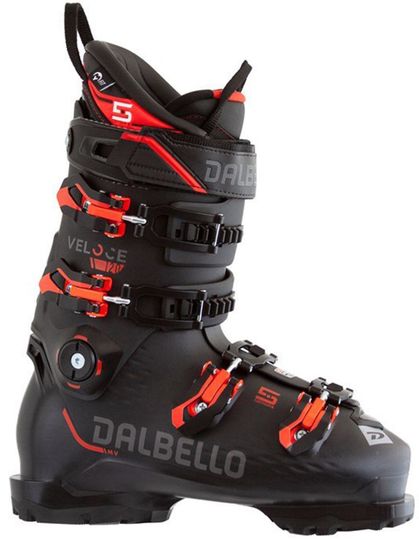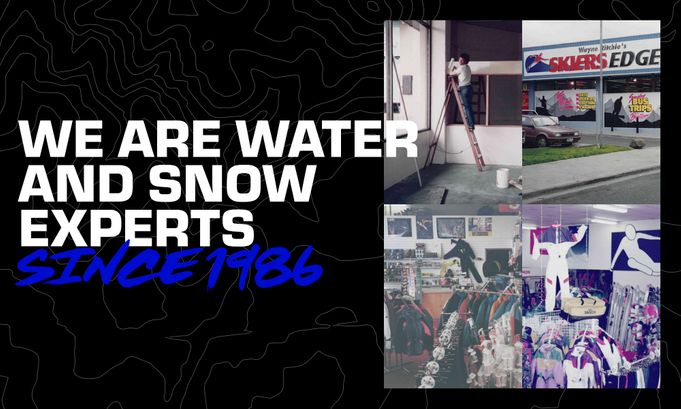We are a group of avid skiers and snowboarders that are passionate about the industry we work in and aim to provide our customers with the best products and service in the industry. Having the right equipment when hitting the slopes can make or break your trip which is why we only stock the highest quality products from the most reputable brands. From skis and snowboards to boots, bindings, goggles, and helmets, we have everything you need to make your time on the mountain as enjoyable as possible. Our staff have years of experience in the snow sports industry and are always happy to share their knowledge and expertise with customers. Whether you're a beginner or an experienced skier or snowboarder, we can help you find the perfect gear to match your skill level and style of riding. If you have questions regarding any of our product, don’t hesitate to get in touch with us via email, phone, socials, or website contact form.
Dalbello 2023 Veloce 120 GW Snow Ski Boots
- Online
- Ringwood Store

Description
The Veloce line has been developed for skiers with a medium foot width who want to combine an exciting day on the slopes with Italian style. The traditional 4-buckle overlap construction, together with new materials and technologies, guarantee a precise fit, delivering support and high levels of comfort with every turn, whether you are carving your way down the perfectly prepared piste or seeking out fresh powder.
Specifications
• CONTOUR 5: For the VELOCE, Dalbello has refined the proven Contour 4 technology to bring the boot’s fit and comfort to a new level, with Contour 5. The inner sidewalls of the boot shell and the liner are pre-formed in five different points to match the anatomical contours of the foot. In the shell, a little extra space has been moulded at four critical fit points: on the inner and outer sides of the forefoot as well as on the instep and the outer ankle. For the 5th contour, the ankle section is pre-formed in the liner. For the first time, Contour 5 technology also emphasises the specific points of added space with a 3D texture on the outside of the shell. The special surface treatment also clearly indicates the points at which the boot has less resistance and can be further customised. This allows boot fitters to make further individual adjustments for customers with minimal effort.
Shipping ETA
| DESTINATION | Small Items < 1kg | Large Items |
| Melbourne Metro | 1 Business Day | 1 Business Day |
| Victoria | 1-3 Business Days | 1-3 Business Days |
| New South Wales | 1-3 Business Days | 1-3 Business Days |
| Queensland | 1-3 Business Days | 1-3 Business Days |
| South Australia | 1-3 Business Days | 1-3 Business Days |
| Tasmania | 2-5 Business Days | 2-5 Business Days |
| Western Australia | 2-5 Business Days | 2-5 Business Days |
| Northern Territory | 3-7 Business Days | 3-7 Business Days |
Warranty
Products sold by Wayne Ritchie's come with consumer guarantees and a minimum manufacturer warranty of 12 months. A manufacturers warranty covers defects that occur during the manufacturing process that result in the product having poor performance or being unfit for use. The manufacturers' warranty does not cover misuse or accidental damage. Minor faults such as delaminations, broken clips, ratchets, laces and tube inners or other replaceable parts will be repaired in a reasonable time frame. Serious faults that hinder use and cannot be repaired such as cracks and tears will be replaced, or a store credit issued for the same value. In the event of a defect, please visit Wayne Ritchies in-store, or submit via the online form. Purchase history must be provided for all claims so please submit your original purchase receipt or invoice. In some cases, a bank statement showing the original purchase date is applicable.
Shipping & Returns
SHIPPING POLICY
Large items over 1 metre cannot be shipped to PO Boxes or Parcel Lockers. Large items are shipped by courier so please provide us with a business or street address where someone will be present at the delivery address between 9am-5pm to sign for the delivery. If you are not present when delivery is attempted we cannot guarantee it will be re-delivered in a timely manner. It may be returned to us or allocated to a third party company which we have no control over, and a re-delivery fee may be incurred in some instances. Once your order has been shipped you will be provided with a tracking number to follow the progress of your order online. It is the full responsibility of the receiver to ensure someone is present at the specified delivery address as there will be no compensation by Wayne Ritchie's for lost or missing parcels. All deliveries notated with "leave at front door" or similar will be left at the buyer's risk, no responsibility will be taken by Wayne Ritchie's for lost or missing parcels.
Incorrect addresses: In the event that you enter an incorrect or invalid address causing your order to be returned to us, a $20 fee will be charged before we can re-send the order to you a second time.
Pick-up in-store: Your click and collect order will typically be ready with 4 hours of placing your online order (during business hours) but this timeframe may differ on weekends and during late night trade periods. PLEASE DO NOT arrive to collect your order until you have received a pick-up confirmation email.
Pre-order items: we cannot provide guaranteed shipping dates but pre-orders are given priority and will be shipped immediately the same day the goods arrive in our warehouse.
We endeavour to keep our extensive online range as up-to-date as possible but if you cannot find what you're looking for, please Contact Us and we will do our best to find it for you.
RETURNS POLICY
Wayne Ritchie's Skiers Edge offers free returns for items that are faulty, not as described or incorrect item shipped. Please return the item to us within 14 days of date of purchase and will will issue a refund or replacement. If you change your mind, an item does not fit or the wrong size is ordered it can be returned to us in the brand new condition you received it and we will happily exchange it or issue a refund. PLEASE NOTE: it is the buyer's responsibility to pay return shipping on change of mind, items that do not fit or have been incorrectly ordered.
*Conditions Apply.
PLEASE NOTE:
- Sale items are offered at significantly discounted prices so please choose carefully as we WILL NOT accept exchanges or returns on sale items.
- Wayne Ritchie's reserves the right to cancel any online order without notice.
- It is the responsibility of the customer to adhere to our terms and conditions as stated above.
- To view our full terms and conidtions Click Here
Visit Us in Store
Experience the largest Australian water sports and snow sports pro-shop in-store! We welcome our customers to enjoy the most immersive range of skis, boards and accessories.
Shipping ETA & Returns
Enjoy free express shipping on all orders over $100, or just $12.95 express shipping on all orders under $100. We'll dispatch orders on the same day if ordered before 12pm.
Get in Touch
We're here to help! If you've got a question regarding our products or services, click below for our phone and email contact details or send us a message via Facebook Messager.
About Us
Wayne Ritchie's is a specialty watersports and snowsports retailer, family owned and operated since 1986. We pride ourselves on an unrivalled customer experience.







